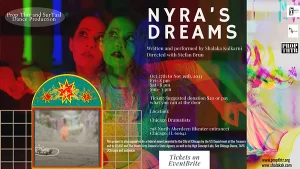
 ** “Nyra’s Dreams” isn’t exactly a dream or a nightmare. This novel production, written and performed by Shalaka Kulkami and directed with Stefan Brün, tells the story of an Indian-American woman, who was adopted as child and who now wants to find herself and her place in the universe. Via a series of dances and soliloquies, Kulkami skillfully narrates the character of Nyra in a 90-minute performance (with no intermission), where she is the only one on stage 99% of the time. What stamina! What vitality! Her gorgeous dancing enthralls us, as each of the gestures she forms with her hands, arms, legs, feet, torso, and head helps to tell the story. They also propel her infectious vivaciousness that rivets us throughout. Yet the storyline is uneven. The narrative evidently has to do with the notion of reincarnation and karma, that is, the nature of the human condition where the soul is constantly being born again until spiritual perfection is achieved. Thus I would recommend that the audience have some background in Hindu religion and culture to make this production easier to understand and follow.
** “Nyra’s Dreams” isn’t exactly a dream or a nightmare. This novel production, written and performed by Shalaka Kulkami and directed with Stefan Brün, tells the story of an Indian-American woman, who was adopted as child and who now wants to find herself and her place in the universe. Via a series of dances and soliloquies, Kulkami skillfully narrates the character of Nyra in a 90-minute performance (with no intermission), where she is the only one on stage 99% of the time. What stamina! What vitality! Her gorgeous dancing enthralls us, as each of the gestures she forms with her hands, arms, legs, feet, torso, and head helps to tell the story. They also propel her infectious vivaciousness that rivets us throughout. Yet the storyline is uneven. The narrative evidently has to do with the notion of reincarnation and karma, that is, the nature of the human condition where the soul is constantly being born again until spiritual perfection is achieved. Thus I would recommend that the audience have some background in Hindu religion and culture to make this production easier to understand and follow.
So the question is: What are Nyra’s dreams? An involuntary pulling motion, done with verve and finesse, constantly forces Nyra to dance—and this movement indicates how she is slowly being pulled away from her life in the contemporary United States and towards her ancestral roots in India. This is in keeping with her desire to become a god and attain a place of spiritual perfection between heaven and earth called Dyavaprthivi. Her ambition is to get close to holiness such that she need not reincarnate into a human being again.
Nyra tells the audience that she is comprised of three souls in one. In order to become a god, she has to find three women living today who correspond to the three souls within her, and she must become acquainted with each with them. Then to be of service, she must ask them pointed questions that she believes is important to their spiritual well-being or might help them get past some difficulty in their lives. Nyra also notes that one of the souls within her once lived a past life as a Devadasi, a holy woman who is dedicated to the worship and service of the godhead as a temple dancer. She tells us that such women once had high rank, but, in the current era, they have largely been demoted among the general population, such that many are prostitutes with pimps. One of Nyra’s most difficult tasks is to find the third woman who is a present-day Devadasi and learn about her holiness.
We never learn how Nyra discovers where each of the three women live or how she finds the resources to go about her journey. Nevertheless, she meets them all. The first woman is presumably from America; the second lives in the Dominican Republic; and the third lives in rural Southern India. She then asks them her telling questions. However, it is only in questioning the second woman that Kulkami constantly exchanges places with her, so as the audience can hear both the question and the answer. This technique unfortunately breaks the flow of the narration; yet it is interesting to watch—to a point. For example, one such question that Nyra asks is: “Are you happy?” But it is unclear why getting an answer to this and similar questions actually teach the disciple about the women’s “strength, frailty, and hope” as described in the program’s synopsis.
Then there is a short experimental film entitled “Nyra’s Dreams”, which we see towards the end of the performance. It feels as if it were thrown in for good measure: to make the show to seem more avant-garde than it already is. It seems superfluous for the purpose of this presentation. Then there is one other character who takes the stage for a brief moment: It is the jailer, who has imprisoned Nyra in a world of reason, which in this tale is a bad thing. Reason keeps a person confined within this lifetime by stifling the imagination and making a person believe that the material world of cold, hard facts is the only reality, making it difficult for an individual to envision past lives, liberation from suffering, and their future existence in the world beyond.
Lorraine Hansberry once said, “I believe that one of the most sound ideas in dramatic writing is that in order to create something unusual, you must pay very great attention to the specific.” This show pays attention to a lot of the specific; and it is very unusual! However, there need to be enough reference points so that a Chicago audience can understand Nyra’s thinking and actions. When a non-Hindu American audience lacks this background, this makes for a seemingly irrational performance. Although I absolutely loved all of the dancing and enjoyed all the music by Sudha Raghuraman and Jayan Nair, something is being lost when trying to bridge cultural differences between that of modern American and Indian culture. Even though the show spectacularly highlights the beauty of contemporary and traditional Indian dance, Nyra’s whole adventure is bizarre. Thus, I would be interested in seeing how this show would play to a modern English-speaking audience in a city like Mumbai or Delhi. It would also be interesting to observe how the production would be received in Southern India in translation into Thanada, one of the lesser known languages of the Indian subcontinent.
“Nyra’s Dreams”, a co-production of SurTaal Dance and Prop Thtr, is playing through November 19, 2023, at Chicago Dramatists, 1109 W. Chicago Avenue, in Chicago.
Tickets are suggested price of $20 or pay-what-you-can.
Performance schedule:
Fridays and Saturdays at 8:00 p.m.
Sundays at 3:00 p.m.
Industry Nights, to be announced.
For information about the show and to purchase tickets, go to: https://www.shalakak.com/surtaaldance.
For information about Prop Thtr and their projects, see: https://propthtr.org/.
For information about Chicago Dramatists and their mission, visit: https://chicagodramatists.org/.
To see what others are saying, visit www.theatreinchicago.com, go to Review Round-Up and click at “Nyra’s Dreams”.






More Stories
“Dummy in Diaspora”
“The Magic School Bus: Lost in the Solar System”
“February House” reviewed by Julia W. Rath